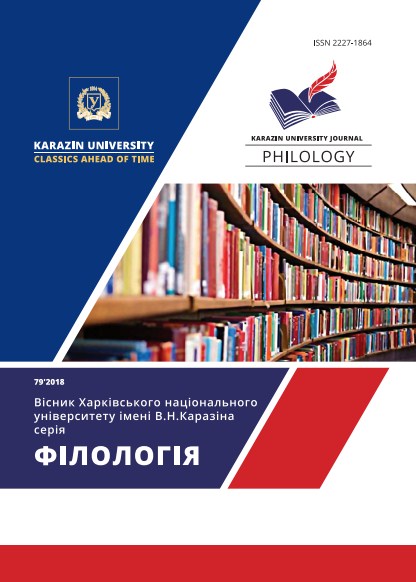Metamorphosis in Odessa. Mythologization of the heroes in the novel "The Five" by Vladimir Jabotinsky
Abstract
At the beginning of the 20th century, Odessa enjoyed the reputation of being the southern trade metropolis of the Russian Empire and one of the most important cultural centers of Eastern European Jewry. Odessa became an area of violence after a wave of strikes, revolutionary uprisings and the most brutal anti-Jewish pogrom in 1905. The novel "The Five" (1936) by V. Jabotinsky represents not only historical events in Odessa of this time, but also reflects the mood of the city and its cultural transformations, mythologizing the destinies of the heroes via the example of one assimilated Jewish family. The focus of this paper is to analyze the mythologization of the main characters and the function that myths from Ovid's "Metamorphoses" performed in Jabotinsky's novel. The novel is a kind of ancient myth that unites some myths and mythical characters. The text also contains examples of the linear development of cyclic time, which leads to the appearance of double figures. The combination of the linear development of time with the use of literary techniques gives the novel the mythopoetic features of literary modernism. The use of myths plays an important role in understanding the text, its intertextual connections and the cultural context of the development of Jewish identity in Odessa in the early 20th century. The process of mythologization helps not only to structure events in the novel, but also is an artistic method of avoiding the cruel reality for an assimilated family in Odessa. The theoretical basis of this analysis is the work of Yuri Lotman on the semiosphere, that reveals the mythologization of the novel and its characters with the help of semantic spaces.
Downloads
References
Литература
Жаботинский, В. Пятеро. Самсон Назорей. Романы / В. Жаботинский – Одесса : Optimum, 2010. – 435 с.
Лотман, Ю. М. Семиосфера / Ю. М. Лотман. – С.-Петербург : Искусство – СПБ, 2010. – 704 с.
Мелетинский, Е.М. Поэтика мифа / Е.М. Мелетинский. – Москва : Восточная литература РАН, 1995. – 408 с.
Фрейд, З. Художник и фантазирование / ред. Р. Ф. Додельцева, К. М. Долгова. – М. : Республика, и настоящее, 1995. – 400 с.
Яковлев В. А. К истории заселения Хаджибея (1789-1795). К столетию завоевания Хаджибея / В. А. Яковлев. – Одесса: Шульце, 1889. – 57 с.
Athenaeus: The Deipnosophists or banquet of the learned of Athenaeus. With an appendix of poetical fragments, rendered into English verse by various authors and a general index; in three volumes. Band 3. London : Bohn, 1854. – pp. 942–943.
Jabotinsky, V.: Memoirs by My Typewriter. In: Dawidowicz L.: The Golden Tradition. Jewish Life and Thought in Eastern Europe. New York; Chicago; San Francisco : Holt, Rinehart and Winston, 1966. – pp. 394–401.
Hetenyi, Zs.: In a maelstrom: the history of Russian-Jewish prose, 1860-1940. (English translation by Janos Boris). Budapest : CEU, 2008.
Lecke, M.: Odessa without Dogma: Jabotinsky´s The Five. Ab Imperio. 1/2012. – pp. 325–350.
Ovid: Metamorphosen. (Lateinisch/Deutsch). Stuttgart : Reclam, 2006.
Samojlov, F.A.: Die Bevölkerung Odessas am Ende des 19. Jahrhunderts: nationaler, sozialer und kultureller Aspekt. In: Koschmal, W. (Hrsg.): Odessa: Kapitel aus der Kulturgeschichte. Regensburg : Lassleben, 1998. – S. 86–95.
Schmid, W.: Elemente der Narratologie. Berlin: De Gruyter, 2014.
Zipperstein, S.: The Jews of Odessa: A Cultural History, 1794–1881. Stanford: University Press, 1985.
References
Zhabotinskiy, V. (2010) Pyatero. Samson Nazorey. Romanyi [Five. Samson the Nazarene. Novels]. Odessa : Optimum. [in Russian]
Lotman, Yu. M. (2010) Semiosfera [Semiosphere]. St.Peterburg : Iskusstvo. SPB. [in Russian]
Meletinskiy, E. M. (1995) Poetika mifa [Poetics of myth]. Moscow : Vostochnaya literatura RAN. [in Russian]
Freyd, Z. (1995) Hudozhnik i fantazirovanie [The artist and fantasy]. Moscow : Respublika, i nastoyaschee. [in Russian]
Yakovlev, V. A. (1889) K istorii zaseleniya Hadzhibeya (1789-1795) [To the history of the settlement of Khadjibey (1789-1795)]. Odessa : Shultse. [in Russian]
Athenaeus (1854) The Deipnosophists or banquet of the learned of Athenaeus. With an appendix of poetical fragments, rendered into English verse by various authors and a general index; in three volumes. Band 3. London : Bohn, pp. 942–943.
Jabotinsky, V. (1966) Memoirs by My Typewriter. In: Dawidowicz L.: The Golden Tradition. Jewish Life and Thought in Eastern Europe. New York; Chicago; San Francisco : Holt, Rinehart and Winston, pp. 394–401.
Hetenyi, Zs. (2008) In a maelstrom: the history of Russian-Jewish prose, 1860-1940. (English translation by Janos Boris). Budapest : CEU.
Lecke, M. (2012) Odessa without Dogma: Jabotinsky´s The Five. Ab Imperio, pp. 325–350.
Ovid (2006) Metamorphosen. (Lateinisch/Deutsch). Stuttgart : Reclam.
Samojlov, F. A. (1998) Die Bevölkerung Odessas am Ende des 19. Jahrhunderts: nationaler, sozialer und kultureller Aspekt. In: Koschmal, W. (Hrsg.): Odessa: Kapitel aus der Kulturgeschichte. Regensburg : Lassleben, pp. 86–95.
Schmid, W. (2014) Elemente der Narratologie. Berlin: De Gruyter.
Zipperstein, S. (1985) The Jews of Odessa: A Cultural History, 1794–1881. Stanford: University Press.




